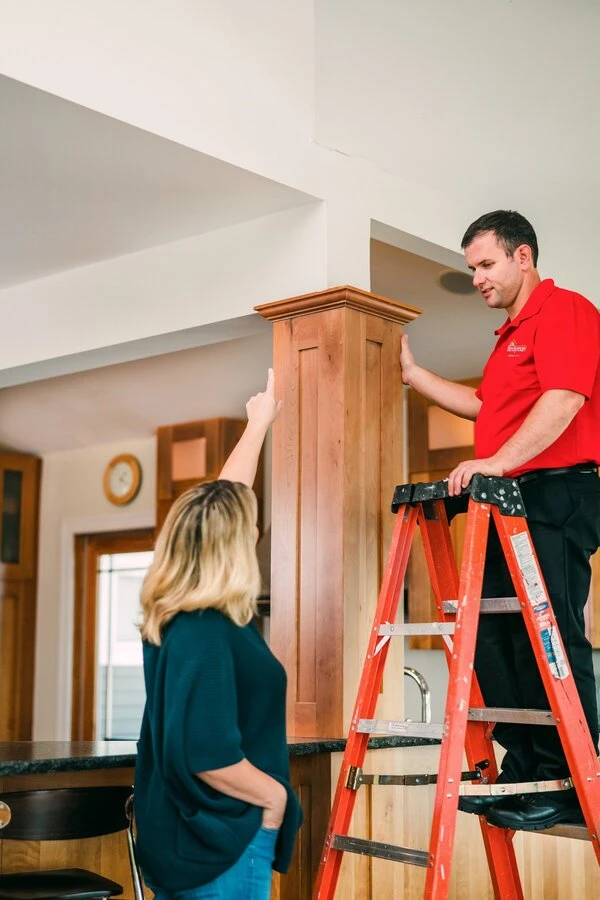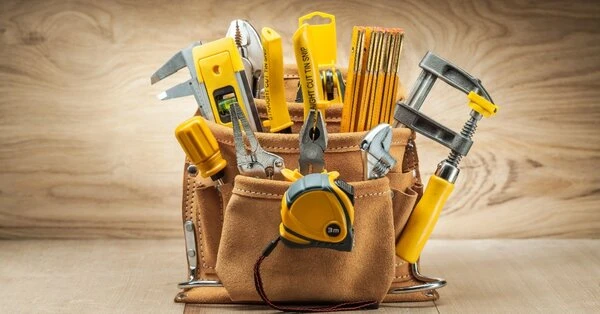We all love our home’s wooden structures as they add a rustic charm to your humble abode. Although wood is used as light structural lumber for many areas of the home from your decks, fence, fascia boards, siding, cabinets, and more it’s also susceptible to rotting away. Wood rot occurs when excessive moisture and fungi, or microscopic organisms, manifest and rapidly grow over time, causing the wood to weaken and break down. As your wood deteriorates, water readily enters the water cavity and increases the damage.
Admittedly, plastic-based materials like vinyl seem to be more popular these days but wood still remains a cult-classic selection. If properly maintained, wood products are more durable compared to plastic as plastic tends to bend, warp, melt and chip easily over time. If you notice signs of decay such as drywall cracks, stuck window latches, buckling in your floor’s surface, discoloration and more your best bet is to rely on a Lehi handyman to give you the quick fix you need. Our qualified, licensed, and fully insured technicians have over 20 years of experience delivering quality craftsmanship and unparalleled customer satisfaction. Our handyman team members will restore your home’s structural integrity to pristine condition no matter the feat.
What Exactly Is Wood Rot?
Wood rot is formally known as wood decay and destroys many hectares of forests each year due to different species of fungi, for example, brown rot, soft rot, and white rot. Wood that has been infiltrated by a fungus will look discolored, and withered away, and be lightweight, soft, and crumbly or powdery in texture. On the forest floor, if a tree has been infected fruiting bodies coined as “conks” will develop along the tree’s trunk and branches, and mushrooms may sprout at the base of the trunk or part of the tree that has been damaged or wounded. The decay process doesn’t happen immediately but takes many years to explain why you may overlook the fact your home’s facets are wearing away until it’s too late. In the natural world, wood rot is removed by pruning dead and decaying branches and wrapping any juvenile trees to prevent rot.
Some areas that are hot spots for wood for your home rot include deck repair, fence repair, siding repair, fascia repair, and window sill repair. No matter how comprehensive the wood rot it’s best not to leave it unattended.
Our Likeable Lehi Wood Rot Repair Services

In the real world, however, it takes a bit more work as your Lehi Handyman has to remove any rotting wood in its entirety before they can attempt a repair usually with an artificial substitute like softwood polyester or using a wood patch. If any damp wood component passes the moisture threshold of 20% it will begin to decay at its core and spread out rapidly. Either way, we wouldn’t outrightly ignore a wood rot repair as you risk permanent structural damage and your home collapsing on you not to mention long-term detrimental health effects due to mold and mildew growth. To make matters worse, many basic homeowners insurance policies don’t cover wood rot damage as it’s not considered sudden or accidental.
Types Of Wood Rot
Brown Rot Or Dry Rot: Dry rot makes wood susceptible to dryness as fungus gets into the wood and breaks down the wood’s cellulose and resulting in shrinkage. As a result wooden structures that uphold heavyweights like your laminate, decks, and ceiling beams will begin to fade. Because wood rot is contagious. Here are some signs of dry rot:
- Damp or decaying timber
- Fine and fluffy white mycelium, a thick network of fungal threads, which grows from a single spore
- Deeper cracks in timber brain
- Brittle or crumbly wood
- Soft, fleshy fruiting bodies
- Discolored patches of orange-brown spore dust
- Odd or musty odors
White Rot: Although less commonplace, wood is composed of lignin which is a polymer that bonds the cells of wood together to allow it its natural rigidity. And once fungus readily invades the wood it digests the lignin and stips the wood's darker colors leaving in place a softer, spongey feel when touched
Soft Rot: Soft rot decomposes wood much more slowly than dry rot or white rot and fungi and bacteria work in conjunction to penetrate the secondary cell walls of the wood. Basically, using a slow but sure approach soft rot tackles the cellulose prior to eating away the lignin. Although less harmful than its counterparts it’s still a nuisance to just leave as is as eventually, it will accumulate enough to affect your home’s structural integrity.
Our Verified Installation Process
Eventually, wood will start to rot as it’s exposed to moisture that’s from a leaky pipe due to a sewage backup or overflowing gutters that splash against your home’s siding. Surprisingly, wood rot treatment is easy to carry out as rot is easy to remove and replace using a few handy tricks including epoxy, wood filler, or wood patches. Here are some of our steps for a wood rot repair using the epoxy solution:
- Remove And Discard: Our expert technician will completely remove the area that contains the rotting piece of loose wood by placing the claw of a hammer at the edge of the rot and slowly chiseling away. We will carefully apply pressure so as not to damage your surrounding healthy wood.
- Router Away: using a router tool with a V-shaped bit we’ll grind away any remainder rot and ensure we uncover the solid and healthier wood underneath. This step is crucial as if any remnants of rot are left behind they can contaminate and begin to spread.
- Sand It Off: We will use a paint scraper or coarse sandpaper to remove any leftover residue on the surface of the wood so any further coats or patches we apply will readily stick to the clean and smooth surface.
- Time To Coat: Next we’ll generously apply a handful of coats of a wood restorer to the designated area. We’ll let it dry for a couple of minutes between coats to allow it to set and then finally let it dry for at least two hours before we proceed to the final steps of patching the area with an epoxy solution.
- Bonding: Now we’ll paint the wood with a bonding agent using a brush.
- Epoxy 2.0: Then we’ll apply epoxy to fill out the entire rotted area by mixing both parts of the epoxy until there is a solid color using a gun applicator.
- Shape Up: Now we’ll shape the epoxy using a putty knife and slowly push it into the crease of the rotted area and press against the edges to set it in place. We’ll scrape off the excess carefully so that the edges and corners of the epoxy solution match the exiting wood so it looks smooth and even.
- Set and Sleep: It’ll take at least 24 hours for the epoxy to completely dry and once it’s ready to go we’ll proceed to sand, prime, and paint it over. For any fixtures outdoors like your deck and fence priming and painting is crucial due to sunlight exposure.
- Wood Patch: This is the backup or alternative method in the wood rot repair process, as you can see it’s intricate and requires dexterity and precision only a Lehi handyman can handle and is not reserved for amateur attempts as doing any step incorrectly means the rot can easily return.
Why We Are Top-Of-Mind For Wood Rot Repair
Don’t let your home’s wood components fade away by signing up for a Lehi wood repair service. Whether you’re in Lehi or nearby areas of Saratoga Springs or Springville our team at Mr. Handyman of Lehi, Provo, and Spanish Fork will restore your woof to its original luster. If you are still hesitant you get peace of mind knowing we offer a no-obligation consultation with onsite estimates, transparent, upfront pricing and a one-year parts guarantee so if for any reason you remain unsatisfied will make the proper adjustments.
Frequently Asked Questions About Wood Rot Treatment in Lehi, UT
What Is The Best Way To Repair Rotted Wood?
For any rotten wood repair, you must remove the rotting area from the original wood board or joists. After this, you should fill the surrounding area with soft wood polyester or a wood patch using a plastic putty knife. Allow the material to harden over and cure to ensure it’ll remain sturdy. For those of you who simply don’t possess the sleigh of hand necessary for wood rot repair, we recommend hiring a local Lehi technician as if you botch the repair it can stick out like a sore thumb.
How Do You Know If Wood Rot Is Active?
If you witness a cotton-like texture or a silky-gray growth along the surface of the wood this is an obvious sign there is fungus growing. You’ll notice that the spores will be a mix of colors from yellow, purple or white within the rotting area which indicates mold and mildew growth.
Does Rotted Wood Continue Rotting?
Yes, most wood rot is not salvageable and needs to be removed and replaced at your earliest convenience as wood will continue to rot. For example, for wet rot there needs to be a lot more moisture for it to spread, while dry rot continues to spread despite the area being wet or moist.
Crumbling Wood No More–Call Us Today For Getting Rid Of Rot!
The longer your delay in addressing wood rot the faster it will spread like wildfire and the costlier the repair or replacement will be. Be proactive about your home’s interior and exterior upkeep by asking one of our expert handyman team members for an inspection during one of the no-obligation consultation appointments. Our technician does the job right the first time and completely removes the decay so it won’t make a comeback. We serve many different areas ranging from American Fork to Highland. If for any reason whatsoever it does re-emerge, we will come back and correct it at no additional cost to you. Reach out to one of our courteous customer service representatives today for a service, or consultation appointment or to learn more about our renovation services.
 Click to call
Click to call


 Click to call
Click to call
